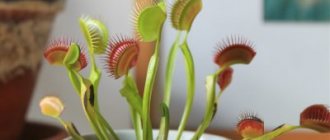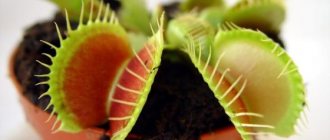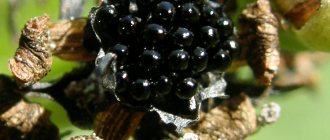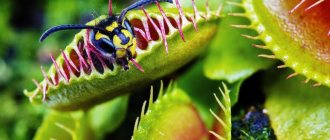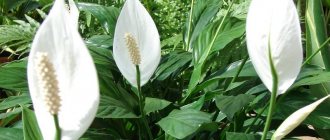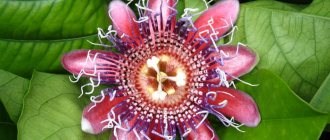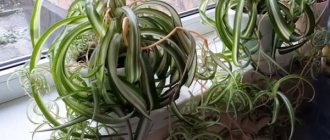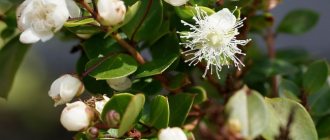How to grow a capricious Venus flytrap on a windowsill: what insects to feed it, how to water and care for it
Many people have heard about carnivorous plants. Some insectivorous plants can also be grown on your windowsill. The Venus flytrap feels great at home and even eats flies, spiders and other living creatures. True, she needs careful and special care. In this article, for those who decide to buy a Venus flytrap, we will try to tell everything about this plant.
Where does the house Venus flytrap grow in nature?
The Venus flytrap is a plant that can only be found on the North American continent, in the state of North Carolina. The flycatcher is listed in the Red Book, and the greatest danger to it is people who dig up the plant for the purpose of selling.
The predatory Venus flytrap is concentrated in one single area with a radius of only 150 kilometers in the vicinity of the city of Wilmington. This area has a temperate and humid climate, influenced by the nearby Atlantic Ocean with its warm currents .
The high mountains of the Appalachians also had a special influence on the fact that the carnivorous plant appeared here
. Their poor soils provoked the appearance of the insectivorous Venus flytrap, which obtains nutrients from ants, spiders and flies.
The Venus flytrap grows in poor soils low in nitrogen and other nutrients. Therefore, it has adapted to obtain the necessary chemical elements by eating insects.
Flycatcher caught prey
How to replant Dionaea
How to replant a Venus flytrap
There is no need for frequent replanting: the soil is not depleted, and salinization when irrigated with purified water is unlikely. It is advisable to replant once every 3 years to divide the bush.
For planting, choose a fairly deep container (the roots can reach a length of 20 cm).
The composition of the soil is depleted: a mixture of perlite and sand, you can add peat and quartz sand.
After transplantation, an adaptation period will be required: keep in the shade for 3-4 weeks, water regularly.
Signs about the Venus flytrap
The Venus flytrap is a windowsill predator, and is usually kept in the house to catch what it wants and catch luck by the tail. At the same time, the Venus flytrap is a symbol of love and femininity. Therefore, the signs associated with it are different.
- It is believed that if a Venus flytrap opened traps in the room where an unmarried girl lives, then the girl will soon have a groom. This flower is very tempting and dangerous for spiders and flies, and at the same time the flycatcher is gentle and capricious, like a real girl.
- If you want to attract a man to you, then you need to place a pot with a Venus flytrap in the room where you communicate. Then the man will definitely be yours. Perhaps this sign has real grounds. Firstly, Dionea exudes a subtle sweet aroma. Secondly, only an extraordinary girl who is guaranteed the attention of men can have such an interesting plant on her windowsill.
Venus flytrap helps girls find personal happiness
- The Venus flytrap is believed to be a plant that brings good luck in business. It helps you not to miss opportunities, be able to distinguish reliable business partners from unscrupulous people, and be in the right place at the right time.
- The Venus flytrap is considered the guardian of the house. She, like a predator, protects the house from people with evil thoughts. Such people will feel uncomfortable next to this plant and will try to leave your home as quickly as possible.
Among the beliefs about the Venus flytrap, there is not a single sign with a negative meaning. Although this plant is predatory and bloodthirsty towards insects, it has positive energy towards people.
Further care
When 2 true leaves appear on the plant, it is necessary to begin hardening. They do this gradually, opening the film shelter for a short period of time. The temperature in the room at this time should not fall below +18 degrees. First, the film is opened slightly for 5 minutes, and then the exposure is gradually increased to 20 minutes.
When Dionaea has 3-5 true leaves, it is transplanted into individual pots. The transplantation procedure is performed with great care, remembering that the Venus flytrap has fragile roots. Dionaea grows very slowly and will become an adult plant only after 5 years.
Watering
When growing a Venus flytrap, you need to constantly monitor the soil moisture. You should not allow it to dry out even for a short time, as this is detrimental to the flower.
House Venus flytrap structure life cycles
The Venus flytrap at home has from four to seven large leaves, on the tips of which traps grow. It is easier to buy an adult Venus flytrap in the warm season. In winter, the plant sheds all its leaves and goes into “sleep”.
During the cold season, the house Venus flytrap sometimes loses all its leaves, and the pot looks completely empty. Don't be alarmed and don't throw away the plant, it's still alive. Continue to care for the tuber in the ground and it is likely that it will delight you with new shoots.
Venus flytrap in a pot
The stem of the flytrap is buried in the ground, and the leaves are near the ground. This is how crawling insects more often crawl into the traps of a predatory plant.
The stem of the plant and its root system are closely located. If you dig up a house Venus flytrap from its pot, you will find a tuber and some fine roots. The structure of the plant resembles that of onions, beets, Jerusalem artichoke and other root vegetables. The Venus flytrap has a wide base and no overgrown roots.
Flytrap root
How does a flycatcher bloom?
Those who grow indoor plants are interested in how and when the Venus flytrap blooms.
Dionia blooms with small white flowers in late May early June. And its flowering is as amazing as the plant itself. A flowering Venus flytrap sends out a long stem on which flowers bloom. The carnivorous Dionia eats naive ants and flies, but “spares” the honey plants that pollinate it.
The inflorescence of the flycatcher is corymbose, similar to the inflorescence of phlox, with small white flowers. These flowers bloom from the buds sequentially: first some, and when the first ones fade, others. The formation of traps at the ends of leaves occurs after flowering.
Blooming Venus flytrap
It is believed that if the flycatcher is still very small, then it is better to cut off the stem thrown out for flowering. It drains a lot of strength and juice from the flytrap. The cut area must be treated with activated carbon, ground into powder.
After flowering, seeds remain on the shoots. Venus flytrap seeds are black and very small. They are hidden in many “boxes”.
Flycatcher seeds
If you look closely or use a magnifying glass, you can see that the seeds of the Venus flytrap are not round, but have a droplet-like shape.
Enlarged droplet-like shiny seeds
Description of the flycatcher
The Venus flytrap is a flower that represents fertility and prosperity. Symbolizes love and sympathy, and can also symbolize the feminine principle.
On the short underground stem of the plant there are no more than 7 leaves, collected in a rosette, 3-7 cm in size. It prefers to grow in swamps with a low nitrogen content in the soil. This deficiency is compensated by eating nitrogen-containing insects - trap leaves are designed for this.
They appear after flowering, on short stems not exceeding 15 cm in length. The traps are green, with a reddish tint. A kind of trap is formed from two sheets, with hairs placed on the edges for better adhesion to each other when triggered.
The glands of the trap produce a special juice that attracts insects. To feast on it, the victim sits on the inner petals and collects nectar. At the same time, special hairs on the trap are irritated, and it instantly slams shut. After the blades are completely closed, a kind of stomach is formed in which the extracted food is digested. After a week of baiting, the trap opens and the cycle is repeated several more times until it dies.
How to grow a Venus flytrap from seeds?
Two things need to be said right away. Firstly, growing a Venus flytrap from seeds is a long process, usually seedlings appear only after a month. Secondly, you need to be very careful when buying seeds from Chinese websites. Unscrupulous sellers sometimes pass off weed seeds as Venus flytrap seeds.
So, if you decide to buy a Venus flytrap in the form of seeds, then in addition to them you will need:
- Distilled water.
- Fungicide Topaz. A fungicide is a fungal control agent for plants. You can buy this product at a flower shop.
- You also need a piece of bandage, gauze, a cotton pad or any other material that is suitable for soaking seeds in it.
- You also need a container for planting and definitely a greenhouse. There should be no draft around the germinating seeds. A greenhouse can be made by covering the peas with glass or film.
Seed germination tactics may vary. If you grew the seeds yourself, you can literally plant them right away. Soak for just a few hours before planting.
It is believed that Venus flytrap seeds have the best germination rate when they are fresh. And it becomes lower literally after 3-4 days.
The first sprouts of a Venus flytrap
But what to do if you don’t have a Venus flytrap and you decide to order seeds by mail? In this case, it is recommended to soak the seeds for a long time before planting.
- Add 2 drops of Topaz fungicide to a glass of distilled water.
- Then a cloth is dipped into this solution and the seeds are wrapped in it.
- The package should be placed in a bag with small holes for ventilation.
- This bag should be placed in the refrigerator. So the Venus flytrap seeds should lie in the refrigerator for three weeks, the fabric should be periodically moistened so that it does not dry out.
- You need to plant a Venus flytrap by sprinkling the seeds onto the ground. There is no need to cover them with anything.
- Then the container with the seeds should be covered with glass or film and placed in a sunny place. In spring and summer, Venus flytrap seeds are germinated in a sunny place on a windowsill. In autumn and winter it is better to place them under a lamp.
Advice from experienced flower growers
When growing a Venus flytrap, even experienced gardeners encounter insurmountable difficulties. In this regard, the following recommendations will be useful for beginners:
- Strict adherence to the watering regime. With excessive watering, dark spots appear on the shoots of Dionaea, and the leaves and stems begin to rot. If such symptoms are present, you need to urgently adjust the irrigation regime.
- Irrigation water and fertilizing. Do not use tap water for irrigation or fertilize with mineral fertilizers. This can cause the leaves to wither and the plant to die.
- Traps. It is strictly forbidden to touch the traps with your hands or feed the flower with products inappropriate for it.
- Lighting. If brown spots appear on Dionaea leaves, this is the result of sunburn. Create translucent shading for the flower.
- Rest period. As the plant enters this period, its leaves may turn white or yellow. They need to be carefully pinched, this will allow new shoots and leaves to grow. During this period, there is no need to feed the plant insects and the watering regime should be reduced to a minimum. The length of daylight hours and the temperature in the room should also be gradually reduced to 7-10 degrees above zero. Even in winter, do not allow the soil in the pot to dry out.
Venus flytrap - the process of eating insects
Venus flytraps have sensitive hairs inside their traps. If you touch only one of them, nothing will happen. But if you touch two hairs in succession, the trap will instantly slam shut.
The interval between touching two hairs can be up to 20 seconds. In this way, the Venus flytrap protects itself from false alarms. And it reacts precisely to insects that move their legs.
Charles Darwin himself called the Venus flytrap one of the most beautiful and amazing plants on our planet. The mechanisms of slamming its traps have not yet been fully studied.
It is believed that it is better to leave the Venus flytrap hungry than to overfeed it. Some gardeners say that the plant only needs 3-4 insects per month. Reference books even claim that a Venus flytrap needs 2-3 insects for a whole season.
Sensitive hairs inside the trap
The Venus flytrap carries out the process of closing the trap in just 100 milliseconds. For comparison, the average time it takes a person to blink is 400 milliseconds. Thus, by the time you blink, the Venus flytrap will have already caught the insect four times.
The Venus flytrap, like other carnivorous plants, lures insects with sweet nectar. It is sticky and found on the bright reddish surface of the trap leaves. The Venus flytrap also exudes an aroma that is not perceptible to humans, but is tempting to insects.
The Venus flytrap completes the digestion process of the insect in 2 weeks. After this, the trap opens again and is ready to meet a new victim.
The Venus flytrap takes 2 weeks to digest its prey.
If you value your pet Venus flytrap, don't slam its traps for fun. One trap can digest seven insects. After that it wears out. “Idle” slamming also harms the plant and weakens its leaves.
Charles Darwin was so fascinated by the Venus flytrap that he dedicated an entire book to it and other plants called “Insectivorous Plants.” In this book, the scientist described the taste preferences of the Venus flytrap.
- Ants make up 30 percent of the Venus flytrap's diet.
- Another 30 percent of the plant's food comes from spiders.
- 10 percent of the plant’s “menu” each comes from beetles and grasshoppers.
- Flies and other flying insects make up only 5 percent of the plant's diet in the wild.
Sometimes the Venus flytrap also eats slugs and snails. There is evidence that there have even been cases of Venus flytraps swallowing small frogs. However, the Venus flytrap at home does not need too large food. The insect should be no larger than a third of the size of the trap. Otherwise, the leaf may not cope and begin to rot.
Venus flytrap eats spiders
From the shoot
Dividing an adult plant is the most acceptable way to grow a flytrap. The shoots are separated from the bush and planted in separate pots of small diameter, but at the same time of sufficient height for the development of long roots.
IMPORTANT. Divide the flytrap as carefully as possible, without touching the traps, otherwise they will close and the plant will get sick.
This plant needs soil that is as light as possible and quite poor. Mix crushed sphagnum moss, peat and sand. There is no need for drainage at the bottom of the pot for a flytrap.
In addition to division, a young plant can be obtained from cuttings . The workpiece is taken without a top trap and planted at an angle with the white part in the peat.
Before placing it in the soil, the workpiece is treated with a root formation stimulator. From above you need to cover the planting with a glass cap to maintain one hundred percent humidity.
IMPORTANT. The sprout takes root in maximum illumination for at least 12 hours a day. After 30-35 days, the cutting will produce its first shoots; a full-fledged root system will be formed in 3-4 months.
Venus flytrap at home: care and watering
The Venus flytrap is a very finicky plant at home. And there is a whole list of conditions that must be observed in order for the plant to develop normally.
Soil for the Venus flytrap
The Venus flytrap is very picky about the soil. She definitely needs acidic peat soil with an acidity level of 3 to 4.5. It is important that the soil is poor, without fertilizers. Sometimes peat soil for a Venus flytrap is mixed with perlite in a two to one ratio. Perlite is an artificial and completely neutral filler. It simply helps to better retain moisture, retain heat and prevent the formation of crusts in the plant pot.
The Venus flytrap can be damaged by any foreign matter in the pot. There is no need to put moss in the pot or plant other plants next to the Venus flytrap. Even the seeds of other plants that accidentally fell into its pot and began to decompose can destroy a delicate flytrap.
The most scrupulous owners even disinfect the soil before planting a Venus flytrap. The soil is dried in the oven or disinfected in the microwave.
Venus flytrap is small and delicate
Watering the plant
- The Venus flytrap should not be watered with tap water at home. The plant will simply die from this. Water the Venus flytrap with distilled water. Some housewives who find it difficult to buy distilled water manage to water the plant by exposing it to the rain.
- You can’t also water the Venus flytrap with a cup or watering can, as we are used to. This finicky plant can only be watered from a tray. That is, you need to pour water into a bowl, and then put the pot in this bowl.
- You can’t constantly keep the plant in a pan of water, but you also shouldn’t let the soil dry out. The soil in the pot should remain slightly moist. In winter, the flycatcher needs less water than in summer.
Watering a Venus flytrap from a tray
Spraying Venus flytrap
The Venus flytrap is a plant that loves moisture. Spray it regularly with a spray bottle. The flycatcher does not tolerate dry and hot air in winter. Therefore, it is advisable to take it out for the winter on a balcony or loggia, where the temperature is not higher than 10 degrees, but not lower than zero.
Venus flytrap and sunlight
The Venus flytrap needs direct sunlight. This plant is very light-loving. And it feels good only if it stands on a window that faces south. As a last resort, Venus flytraps are placed on windows facing east. In summer, it is advisable to take pots with flycatchers to balconies and loggias, where there is a lot of light.
Direct sunlight is beneficial for the Venus flytrap
Plant propagation and transplantation
The encyclopedia of indoor plants recommends replanting the Venus flytrap once every 1-2 years. This should be done in late spring or early summer.
The plant can reproduce by seeds and budding. To budding, you need to carefully remove the bulbs growing together from the ground and separate them. But you shouldn't do this too often. The fact is that plants do better when they grow in groups.
Seed germination
Start by preparing the soil. You can use the same soil as for an adult flytrap, which consists of sphagnum peat that has been washed with minerals (run distilled water through it and let it drain 4 times), with other substances as desired, such as quartz sand or perlite. No "potting mixes" because they contain minerals that will kill venereal flytraps.
Soil selection
Next, prepare a container or pot. This container is designed to keep the seeds moist and warm, but must allow air circulation. As an alternative growing container, you can also use any ordinary pot, which is covered with a transparent plastic bag on top.
Moisten the potting mix with distilled water and place the potting soil in a container.
How to plant correctly
Do not bury seeds in the ground. Instead, scatter them on top of the moist growing medium and then sift very fine dust of sphagnum peat moss over the seeds. The very light pollen helps retain moisture and keep the emerging root from drying out and becoming calloused and stunted. However, the seeds should only be very lightly covered, to the point that you can still see them through the dust, otherwise they may not germinate. If you can no longer see the seeds after dusting them with sphagnum peat moss, there is too much dust.
Spray distilled water onto the moss and cover the container with a ventilated lid. Once most of the seeds have sprouted, the coating can be permanently removed within 4-6 weeks.
VIDEO: How to take care of a Venus flytrap?
Our website has many other interesting articles about growing indoor plants:
- Why don't violets want to bloom?
- Mother-in-law's tongue. How to properly care for this plant.
- Energy of indoor plants.
- Caring for cacti.
- Spathiphyllum flower or “female happiness”, signs about the plant and caring for it.
- Orchid on the windowsill.
